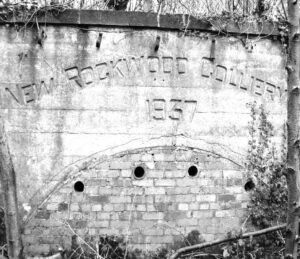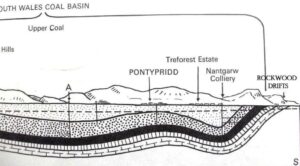Nantgarw, Taff Vale.
 This mine was opened in 1937. It was located approximately one mile south-south-east of Nantgarw Colliery and to the east of Taffs Well. It was flanked by the old Pond and Bryncoch collieries to the north and was driven in just below the Upper-Nine-Feet (Wing) seam.
This mine was opened in 1937. It was located approximately one mile south-south-east of Nantgarw Colliery and to the east of Taffs Well. It was flanked by the old Pond and Bryncoch collieries to the north and was driven in just below the Upper-Nine-Feet (Wing) seam.
In 1937 a contract was made to make a formation level and remove part of the old colliery tip, to install a railway. A screening plant was erected. A start was made in 1937, by driving an open cutting, between the Barry and Rhymney railways, and a level cross-measure drift or tunnel, known as No. 3 Main Mine was driven northeast to the Black vein, reached after about 250 yards and 40/50,000 tons was worked in this area.
They then started a new drift, the Black Vein Drift, at the higher level, near Graig-yr-Allt farm. This struck the Black Vein in December 1939. The company decided to temporarily stop the No. 3 Main Mine to continue it at a later date, to connect directly to the workings of the Black vein at the 1,246 feet level. In May 1940, two new drifts were opened approximately 1,200 yards further up the mountain from the original drifts. The one was driven for a distance of 140 yards to hit the Black Vein and the other 60 yards into the Wing seam.
Good progress is being made with developments at New Rockwood. A bore on the hillside proved the Black vein, seven feet thick, Wing five feet, Slatog six feet, Fork five feet two and Brass six feet six. Slants have been driven in the Black Vein for a distance of 140 yards and a slant in the Wing coal for 60 yards. Drifts are about 1,000 yards from the screens.
 Then confusingly the No.2 Drift was opened in 1944 and the No.3 Drift in 1947. The Black Vein or Wing Vein Drift was driven into the outcrop of that seam and was located higher up the mountain to the east of the main colliery. In 1943 it employed 144 men working underground in the Fork, Brass and Black Veins and 42 men working at the surface of the mine. W.D. Evans was the manager. In 1946 a level cross-measure drift was driven from the Black vein drift and intercepted the Red, Grey and Big Limog seams. This cross-measure drift is then held for future development.
Then confusingly the No.2 Drift was opened in 1944 and the No.3 Drift in 1947. The Black Vein or Wing Vein Drift was driven into the outcrop of that seam and was located higher up the mountain to the east of the main colliery. In 1943 it employed 144 men working underground in the Fork, Brass and Black Veins and 42 men working at the surface of the mine. W.D. Evans was the manager. In 1946 a level cross-measure drift was driven from the Black vein drift and intercepted the Red, Grey and Big Limog seams. This cross-measure drift is then held for future development.
The BODWR TUNNEL was driven on a level gradient near Graig-yr-allt farm, from the surface for 200 yards. This tunnel is left for future development.
Frank Hodges was a strange choice for a chairman of a colliery company. He was born at Woolaston, Gloucester, in 1887. Commenced work at Powell’s Tillery Pits, Abertillery, after leaving school at the age of 14 years. He secured a scholarship to Ruskin College, Oxford, from 1909 to 1910. He then rose rapidly through the ranks of the miner’s movement and was appointed Miners’ Agent, Garw Valley South Wales Miners’ Federation, 1912, then to the illustrious post of Secretary, Miners’ Federation of Great Britain, 1919. On top of this, he was the civil Lord of the Admiralty in the first Labour Government. He resigned the secretaryship of the Miners’ Federation of Great Britain, on January 31st, 1924, on appointment as Civil Lord of Admiralty. Appointed Permanent General Secretary of the International Miners’ Federation, 1924 (resigned 1926). Vice-Chairman, National Fuel and Power Committee, 1926. Appointed member of the Central Electricity Board, 1926. Chairman of The Leicestershire Colliery & Pipe Co. Ltd. Chairman, The Glasgow Iron & Steel Co. Ltd. Chairman, New Rockwood Colliery Ltd.
On Nationalisation in 1947 the colliery passed from the hands of the New Rockwood Colliery Company Limited into the National Coal Board’s, South Western Division’s, No.5 Area. At that time it employed 35 men on the surface and 168 men underground working the Brass and Black Vein seams for gas and manufacturing coals. It comprised of the Wing Vein Drift, Black Vein Drift and Bodwr Drift. The Main Drift and Companion Drift were closed. It was still managed in 1947 and 1954 by W.D. Evans. In July 1949 the Coal News reported that eight brothers were working at this colliery, together they had 264 years of experience in working underground, with their father, Llewellyn Atkins, having worked 45 years underground.
Pit head baths were erected in 1950. It was in this year that output records were broken, in six days 2,335 tons of coal was raised, of which 2,332 tons were saleable. It was reported that the New Rockwood men had always worked the voluntary Saturday, and on that occasion 219 of the 243 men turned up for work. Output per manshift was 38.2 cwts gross, 37.8 cwts saleable the best production figures ever for this colliery. The coal was hand-cut using 48 pneumatic picks.
In 1955 out of the total colliery manpower of 255 men, 125 of them worked at the coalfaces, this figure was 127 men at the coalfaces in 1957 and 120 men working at the coalfaces in 1958. In 1959 it was working the “Wing Vein”. In 1961 NewRockwood Colliery was still in the No.5 Area’s, No.5 Group along with Nantgarw Colliery. This Group employed 778 men and had a total coal production for that year of 164,815 tons. This colliery had always made a profit until 1962 when losses were £0.13 per ton, losses increased downwards to £0.97 per ton of coal produced in 1963. At that time it was working the Black, Wing and Brass seams at inclines of 34 degrees and 4,000 yards in from the mouth of the drifts. In 1958 there had been 117 colliers working at this mine but by 1963 there were only 51 left. The NCB considered allocating the rest of the reserves to Nantgarw Colliery but possibly due to poor results at Nantgarw, it remained open. The two mines were connected from the bottom of the No.3 Drift but were never worked as one unit.
New Rockwood Colliery was closed on the 25th of May 1963. The NCB claimed that the workings were too far in to be economically worked. Two Hunslet diesel locomotives were used to bring the coal out to the drift bottom. Right to the end there was no screening plant or washery at Rockwood, the coal was taken directly to the GKN works at Cardiff.
Some statistics:
- 1937: Manpower: 17.
- 1938: Manpower: 52.
- 1945: Manpower: 186.
- 1947: Manpower: 203.
- 1948: Manpower: 221. Output: 83,330 tons.
- 1949: Manpower: 270. Output: 83,330 tons.
- 1950: Manpower: 266.
- 1953: Manpower: 251. Output: 91,175 tons.
- 1954: Output: 87,411 tons.
- 1955: Manpower: 255. Output: 86,541 tons.
- 1956: Manpower: 253. Output: 84,810 tons.
- 1957: Manpower: 243. Output: 75,352 tons.
- 1958: Manpower: 248. Output: 69,474 tons.
- 1961: Manpower: 160. Output: 48,454 tons.
ROCKWOOD COLLIERY
Nantgarw, Taff Vale (some national grid references 124842/130843/126842/130845)
The earliest, of the numerous drifts for this mine was at NGR 124842 it was known as the Rockwood/Bryncoch Black Vein Drift. It is shown in 1907 as employing 32 men and in 1908 as being managed by T.B. Shearn and employing 45 men underground and 7 on the surface. In 1910 another drift at NGR 30849 was opened and called Rockwood 2nd Phase, although on the HM Inspectors lists they are Nos. 1 & 2 Rockwood.
In 1913 it was still managed by J.B. Shearn and employed 149 men in the Nos. 1 and 2 Levels. It employed 220 men in 1915 and 200 men in 1916 with Mr. Shearn still the manager. In 1918 S. Bryant was the manager and it employed 179 men, in 1920 it employed 200 men while in 1923 it produced 70,000 tons of coal with 224 miners. In 1927 D. Davies was the manager and it employed 250 men. When the colliery stopped in 1927 the GWR. took up the junction (on 15th May 1927) only to have to put it back after the Receiver of Rockwood Collieries Ltd. reopened the colliery on 30th August 1927. The facilities were finally removed in May 1931.
It was owned by the Rockwood Colliery Company Limited until this company went into receivership in 1930. At that time it employed 64 men working underground and 16 men at the surface of the mine and produced 26,000 tons of coal. The Rockwood Company was not a member of the Monmouthshire and South Wales Coal Owners Association. This mine mainly worked the Meadow Vein (Yard/Seven-Feet), Bute and Six-Feet seams. It was replaced by the New Rockwood Colliery.
Some statistics:
- 1907: Manpower: 32.
- 1908: Manpower: 52.
- 1909: Manpower: 5.
- 1910: Manpower: 94.
- 1911: Manpower: 78.
- 1912: Manpower: 155.
- 1913: Manpower: 149.
- 1915: Manpower: 220.
- 1916: Manpower: 200.
- 1918: Manpower: 179.
- 1920: Manpower: 200.
- 1922: Manpower: 200.
- 1923: Manpower: 224.
- 1924: Manpower: 264.
- 1925: Manpower: 250.
- 1927: Manpower: 250.
- 1930: Manpower: 80. Output: 26,000 tons.
Information supplied by Ray Lawrence and used here with his permission.
Return to previous page
